|
First anniversary of the Eastern Liberation:
East like phoenix rises from ashes
Shanika Sriyananda reporting from Mavil Aru
[email protected]
|
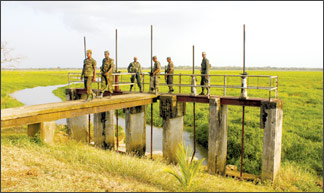
Mavil Aru anicut
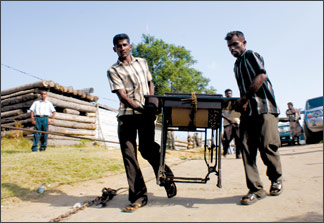
Pix: Chaminda Hittatiya |
|
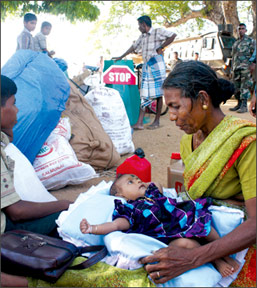
Within a year of liberating the East, people who had experienced
the bloody terrorist war and violence are now breathing fresh
air. Still undergoing many economic and social hardships the
people enjoy the newly dawned freedom, hoping and praying for a
bountiful future.
|
Snarling through the newly built bund, the dust and heat greet us
showing the signs of the rustic life of an area always burdened with
hardships.With no mercy, the sun bakes the ‘soil as well as the skin’.
The embarkment built with fresh red soil to prevent flooding which in
undates the entire area with more than 15 feet under water. The sluice
gates was the landmark of a humanitarian mission to liberate the fertile
Eastern province, where thousands of Tamils were held as human shields,
from the paws of the LTTE.
Mavil Aru
Despite the scorching sun the tractor drivers and labourers were busy
levelling new bund, a stretch of over three kilometres, happy with the
Ministry of Nation Building for giving them job opportunities.
“This is the first time that we have cultivated large acreage of
paddy lands after liberation of the East. The LTTE terrorists while
holding the Mavil Aru anicut, some farmers were chased away and some
were killed. We abandoned these lands until the military captured and
restored peace”, says H.M. Tikiri Banda, a paddy farmer in Mavil Aru
since 1978.
With the closure of the Mavil Aru anicut by the LTTE depriving them
of water for over 30,000 people on July 22 in 2006, the security forces
launched the ‘Operation Watershed’ to gain control of the Mavil Aru,
which supplies water for all three communities. The military mission
successfully come to an end on last August 11.
Expecting a bumper harvest this time he says that there is no other
better fertile soil than Mavil Aru where there is no need of chemical
fertilizers to boost the yield.
The security is fully strengthened by the security forces in Mavil
Aru and over 300 families in Medagama, Kalara ran to Kantale for life as
the LTTE closed the Mavil Aru anicut denying their rights for water.
Living in welfare centres in Kanthale for months they have now returned
to their homes.
The young and the old have now started life afresh. According to
statistics there were over 17,410 hectares of paddy lands in Mavil Aru
in 1990s, but now after liberation it has increased to over 30,000
hectares.
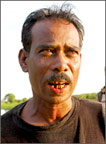
H.M. Tikiri Banda |
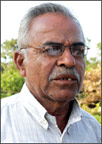
Ratnasingham |
A sense of freedom and happiness has been written on their faces. The
agony and the painful memories of an era under the LTTE control, where
the innocent farmers were abducted and killed, is fading off.
“With the closure of Mavil Aru we did not have water to drink. We
were forced to abandon our main livelihood, the agriculture and as the
terrorist threats increased, we fled to Kantale with our children and
old parents. “We were totally helpless without water”, recalls G. Kanthi
(42), a mother of three children.
Thanking the security forces for liberating them while sacrificing
their own lives, the villagers in Medagama say that they are happy as
they can now freely move around in Tamil villages. Seventy five-year-old
D.M. Tennekoon and T.D. Wijeratne (62) from Sirimangalapura say that
they lack job opportunities and meet their daily expenses by doing odd
jobs. “But they are happy, because today we live without fear”, they
claimed.
After several years the temple bell now rings bringing peace of mind
to many Buddhist villagers, whose lives were always under threat. The
daily religious rituals in temples as well as in kovils bears testimony
to the fact that life in Mavil Aru has returned to normal. People of
Mavil Aru now are counting their days to collect a bumper harvest in
coming September.
Vakarai
We are crossing the infamous Panichchankerni Bridge, which was the
final push to capture Vakarai. In its long march to free the people of
the East, the security forces from Mavil Aru stepped into the LTTE
stronghold Vakarai, destroying LTTE Leader Prabhakaran’s dream of making
Trincomalee, the capital of Eelam.
|
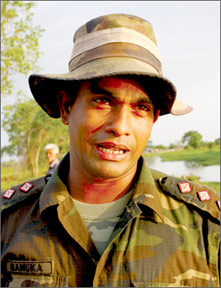
Captain Banuka Wickramaratne, Officer
Commanding Mavil Aru
“ These people suffered a lot as they did not have water even to
drink. They abandoned their cultivations and had gone to IDP
camps in Kantale. After the capture of Mavil Aru anicut by the
security forces, this is the first time, they have started their
cultivations. The security forces and the Department of
Irrigation are helping them. This new bund is built as a measure
to prevent recurrent floods. The security of the Mavil Aru is
fully strengthened at present”. |
Today Panichchankerni bridge stands tall after reconstruction with
more strong iron bars around. The security forces in its five months
long battle captured Vakarai on January 19, 2007 freeing over 30,000
civilians from starvation.
Over 10,000 people who were denied basic needs and used as human
shields, fled the Tiger controlled areas as the military entered the
Vakarai.
The town, which already shelters IDPs from Sampur, gave refugee to
those civilians who fled in thousands. With the Vakarai Rural Hospital,
which was used to treat the LTTE cadres with bunkers and artillery
positions around it the landscape tuned into a tent-city overnight.
In the year of its liberation, Vakarai is now breathing fresh air of
freedom with maximum security provided by the security forces.
New buildings are coming up and the hospital has been upgraded into a
Base Hospital. With no refugees, the displaced people in Vakarai have
been resettled.
G. Kaneshan with his family and an another family with a van load of
their belongings are waiting to cross the Verugal through the ferry to
go to Killiwetti IDP camp.
The Verugal, the entrance to Trincomalee is a hive of activity with
hundreds of another batch of refugees from Valachchenai crossing the
river using the ferry. No luxury items, but the most valuable assets of
the majority of them, are their sawing machines.
Undergoing tough security check-ups, which unload each and every
gunny bag full of aluminum pots, pillows, mats, and even clothes and
other accessories, these people carrying new born babies, born in their
refugee camps, are brimming with hopes of a better future. Entertaining
hopes for a better future, most of them are going back to their original
lands.
As the fighting was escalating and troops were advancing, Kaneshan
ran with his children to Vakarai and from there to an IDP camp in
Valachchenai.
“ The LTTE charged them for using the ferry to cross the Verugal
river. The LTTE conscripted underage children and my children were small
at that time. They taxed us’’, says Kaneshan who earned a small living
as a labourer.
The two children, Thayanandani and Anisha who attended the Koralamadu
School in the IDP camp will find a new school in Killiweddi.
Sixty five-year-old Ratnasingham, a former Principal is at Verugal
waiting to return to his village in Thangapuram. Being a refugee at the
Batticaloa IDP camp, he is returning to his old house after a lapse of
three years. Hoping to start a new life, he says, that people are happy
as they are going back to their original lands.
“ We do not want the war. We suffered and experienced the war badly.
We want to start our lives and live in a peaceful manner. Lots of
children and elders including women were taken away by the LTTE
forcefully. They used us as a shield”, Ratnasingham says that he feels a
sense of security as the military is present in the area.
It is an arduous job to check all the bags and baggages of the IDPs.
But the young soldiers and their female counterparts keeping their very
watchful eyes check every thing that carried across. “We do not take a
chance. It is a tiring job. But there is no chance for any one to carry
‘unwanted things’ with them’’, the young Captain in charge of checking
said.
Not only here but in every check point manned by the army and the STF
together with the Police the civilians are closely screened leaving no
room for LTTE infiltration into the villages.
In all these areas, people have started their day to day lives. New
shops have come up at every corner. Schools and government offices are
now functioning. Most of these buildings and houses have been
color-washed. Road construction have begun and the people have found new
jobs in those new sites.
J. Moosin is a three-wheeler driver who had his vehicle at
Thiyawattawan junction with 10 other three-wheelers. Complaining about
poor daily earnings, he said he is happy that the military is
controlling the security in this once LTTE controlled area.
He says under the LTTE control they suffered for four years. The
people were abducted by the LTTE and imposed taxes which were unbearable
to the civilians.
The sight of new resettlements are evidences itself that the life in
the East has began afresh after so many years of violence and war. Still
undergoing immense hardships like water, finding jobs and other social
agonies, the people say that they have hopes for a better future for
their children! They are trying to rise up from the ashes of war and
misery.
Thoppigala
In these villages, the youth did not move around at night earlier in
fear of conscription. Now they are seen playing volley ball in barren
lands cleared of mines. Schoolchildren walk alone back from school.
Pulakadu in Thoppigala, is another village where over 300 families
have been resettled. They lost their houses made out of bricks and also
temporary structure due to war. Living in temporary shelters where there
are no cement floors, the villagers are happy that the government and
the security forces have taken steps to speed up resettlement process.
“Otherwise, we have to stay many years in IDP camps. This time the
government has taken steps to clear all landmines with the help of the
security forces and NGOs in these areas. They are now free of land
mines,” says Nagamuththu Pillaiyan (54) whose livelihood is agriculture.
He said that during the LTTE control they were forced to pay taxes
for cultivation, fishing and even making fire wood. “They forced the
villagers to give their children over to the LTTE. We tried our best to
protect our children from the LTTE. Some young girls and boys got
married to survive but in some instances they took the married couples
as well”, he complains.
Water is no major problem for these villagers but sanitation needs
attention.
The villagers flock to the Pulakadu Kovil for the pooja for the God
Mariya praying for rain. The women were busy preparing kiribath (milk
rice), sweets and rotti while men and children were engaged in
decorating the small kovil with yellow polythene sheets.
Kanaka Pullai is a grandfather who looks after his grandchildren as
his son, Thangaraja, was abducted by the LTTE. “The LTTE abducted lots
of young people like my son and when we went to inquire about their
whereabouts we were assaulted. Still we do not know whether they are
living or dead! It is a great relief that the security forces have
liberated us.
We, especially our small children can enjoy peace now”, the old grand
father still grieves for his son as his three young daughters have
become a burden to the old man.
Punidhavani (30), a mother of two small children pawned her jewellery
and started a small boutique in the village. As her husband does not
have a job, the couple depends on the small profit they earn from the
sales. She says it is not possible to run the business as most of people
come to buy things on credit. “It is difficult to pay the money back as
they do not have jobs.
Ultimately I do not get money to fill the stocks”, she complained,
saying the soda, betel and cigarettes have the highest demand.
Sandiveli ferry, which was renovated and guarded by a small Army
detachment, is the gateway for these villagers to Batticaloa and Vakarai
to obtain medicine and to necessary food items.
The ferry operated under LTTE control and taxed people for each trip.
Over 480 people travel daily, to and from Thiladedi.
At Illuppadichena, where Sergeant Pathira was brutally killed during
the operation to capture Thoppigala, the people are moving around freely
and engaged fully and confidently in their day to day activities.
The festivities the Sivamuthumari Ambal Temple, where they have
started the annual festival can be heard all over the junction. People
living in the surrounding areas will visit the temple which is the
biggest kovil in Thoppigala, for the annual festival.
The STF which took over the control of the area from army is giving
their fullest support to the villagers who returned to their lands.
After many months, the drizzling have started just after few days of
the festival where the devotees are paraded around the Illuppuduchena
daily. With no major festivals as such when these 360 families were
under the control of the LTTE, they just worshipped the Gods.
The fear that these villagers had for our security forces is
gradually fading away as most of the young soldiers communicate with
them in their own Language, Tamil. These young soldiers who are very
friendly with the villagers living around their camps in some days
sacrifice their lunch and distribute the food among villagers who still
depend on the rations.
“We have seen, death, destruction and war everywhere and this is the
first time we have witnessed how people try to rise up from destruction
and their struggle for survival. Earlier we captured land and just moved
forward but this time we are there helping them to develop their lives.
We, the soldiers are happy to see this change”, says Major Thushan
Silva who accompanied us to Vakarai.
The security forces have helped to address the hardships faced by
villagers in the resettlement areas.
In Pullipanchgal a new milk collecting centre has come up to
facilitate the livestock farmers. Earlier they had to travel more than
20 kilo meters to Kiran and Sithandi to sell their milk.
The LTTE had taken half of their collection on the way and they had
once abducted a vehicle belong to the Highlands Milk Company.
|
